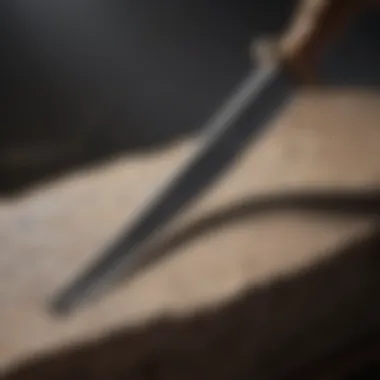Mastering the Art of Stone Cutting: The Definitive Blade Selection Guide


Rock and Fossil Identification
In the world of rock and fossil collecting, understanding the types of rocks and fossils is fundamental. Different rocks such as sedimentary, metamorphic, and igneous offer unique characteristics that enthusiasts must identify. Sedimentary rocks like limestone often contain fossils, while metamorphic rocks like marble display intricate patterns. Knowing these distinctions aids collectors in honing their craft.
To effectively identify rocks and fossils, collectors must pay attention to various characteristics. Fossils, for instance, may exhibit imprints of ancient creatures or plants, providing clues to their origins. Observing the color, texture, and density of a rock can also offer insights into its composition and formation history. By mastering the art of observing these details, collectors can enhance their ability to discern between different specimens.
Utilizing the right tools is paramount in rock and fossil identification. Equipment such as magnifying glasses, chisels, and brushes play crucial roles in uncovering intricate details and delicately extracting fossils from rocks. These tools enable collectors to handle specimens with care and precision, ensuring the integrity of each find remains intact.
Introduction
In the realm of stone cutting, the choice of blade holds pivotal importance, dictating the efficiency and precision of the cutting process. This article serves as a beacon for enthusiasts and collectors embedded within the fascinating world of rocks and fossils. By unraveling a myriad of factors and nuances, readers will unearth invaluable insights to elevate their stone-cutting pursuits to new heights.
Understanding the Importance of Choosing the Right Blade
Factors Affecting Stone Cutting Efficiency
A critical facet in the stone cutting domain is the efficiency of cutting, heavily reliant upon various factors. Factors such as blade material, design, and sharpness play a crucial role in determining the efficacy of the cutting process. Understanding these intricate dynamics ensures a seamless and precise cutting experience, optimizing the outcome for enthusiasts. Embracing the right factors that enhance stone cutting efficiency is fundamental in achieving top-notch results, making it a cornerstone in the realm of stone cutting.
Types of Stones and Their Cutting Challenges
In the labyrinth of stone cutting, different types of stones present unique challenges that enthusiasts must navigate. Each stone variant comes with its set of characteristics, hardness levels, and patterns, requiring tailored cutting techniques. By delving into the diverse landscape of stone types, individuals can grasp the specific challenges posed by each variant. This insight enables enthusiasts to strategize their cutting approach, maximizing efficiency and accuracy. Acknowledging and addressing the cutting challenges posed by various stones is a key element in mastering the art of stone cutting.


Blade Material and Composition
Blade material and composition play a pivotal role in the realm of stone cutting, making it a crucial aspect to explore in this comprehensive guide. When it comes to selecting the best blade for cutting stone, the material and composition of the blade are paramount considerations that directly impact cutting efficiency and overall performance.
Diamond Blades
Segmented vs. Continuous Rim Blades
Segmented and continuous rim blades are two prominent variations when it comes to diamond blades. Segmented blades have gullets between the segments, allowing for better cooling and debris removal during cutting. On the other hand, continuous rim blades offer smoother cuts with their continuous rim of diamond around the circumference. Understanding the differences between these two types of diamond blades is essential in choosing the most suitable blade for specific stone-cutting tasks.
Segmented blades excel in tackling tough materials like concrete and granite due to their robust design and efficient debris removal capabilities. On the contrary, continuous rim blades are ideal for precise cutting of delicate materials like ceramic tiles and marble, providing clean and chip-free cutting edges. Each type has its distinct advantages and is selected based on the nature of the stone being cut, emphasizing the significance of choosing the right blade for enhanced cutting performance
Diamond Grit Size and Bond Type
The diamond grit size and bond type are critical factors that determine the cutting efficiency and longevity of diamond blades. Diamond grit size refers to the size of the diamonds embedded in the blade, affecting the aggressiveness and smoothness of the cut. A finer grit size results in smoother cuts ideal for materials like glass and ceramic, while a coarser grit size is more suited for harder materials such as concrete and stone. Bond type, on the other hand, refers to the material that holds the diamond grit in place. Different bond types cater to varying cutting needs, with softer bonds providing faster cutting speeds and harder bonds offering extended blade life.
Choosing the appropriate diamond grit size and bond type is essential for optimizing stone-cutting endeavors, ensuring precision, durability, and efficiency. By understanding the unique features and advantages of different diamond blade configurations, enthusiasts can elevate their stone-cutting experience and achieve impeccable results.
Blade Size and Configuration
In the realm of stone cutting, the aspect of blade size and configuration holds significant importance, dictating the efficiency and precision of the cutting process. The size and configuration of the blade play a crucial role in determining the overall outcome of the cutting task, making it a critical consideration for enthusiasts and professionals alike. By carefully selecting the appropriate blade size and configuration, individuals can ensure maximal performance and optimal results in their stone cutting endeavors.


When it comes to blade size, one must take into account factors such as the dimensions of the stone to be cut, the desired precision of the cuts, and the intricacy of the design to be achieved. Larger blades are typically employed for cutting through more massive stones or for making long, straight cuts, while smaller blades are favored for intricate designs and detailed work. Additionally, the configuration of the blade, including the arrangement of teeth or segments, impacts the cutting speed, smoothness, and accuracy of the cuts. An improper size or configuration can lead to inefficiencies, material wastage, or even damage to the blade or the stone being cut. Hence, selecting the right blade size and configuration is essential for achieving optimal results and enhancing the overall stone cutting experience.
Choosing the Appropriate Diameter
Impact of Blade Thickness on Cutting Precision
The impact of blade thickness on cutting precision is a critical consideration that influences the quality and accuracy of the cuts made during the stone cutting process. Blade thickness plays a pivotal role in determining the level of control and stability during cutting operations, affecting factors such as blade deflection, material removal rate, and the smoothness of the cuts. Opting for a blade with the appropriate thickness ensures greater cutting precision, reduced chipping, and enhanced durability, resulting in clean cuts and minimized material waste.
An ideal blade thickness strikes a balance between rigidity and flexibility, allowing for efficient material removal without compromising the structural integrity of the blade. Thicker blades offer increased stability and decreased vibration, leading to smoother cuts and improved cutting accuracy. However, excessively thick blades may encounter resistance and generate excess heat during cutting, potentially causing damage to the stone or the blade itself. Conversely, thinner blades provide greater flexibility and agility, enabling intricate cuts and curved designs with ease. Nevertheless, thinner blades are more susceptible to deflection and may exhibit lower durability under high-stress cutting conditions.
In the context of this article, understanding the impact of blade thickness on cutting precision is paramount for readers keen on optimizing their stone cutting processes. By selecting the appropriate blade thickness based on the specific cutting requirements and material characteristics, individuals can achieve superior cutting results, maintain blade longevity, and elevate their overall stone cutting experience.
Cutting Techniques and Best Practices
When it comes to cutting stone effectively and efficiently, mastering the right techniques and adhering to best practices are paramount elements that cannot be overlooked. This section aims to delve into the significance of cutting techniques and best practices within the context of selecting the optimal blade for stone cutting. Understanding and implementing the appropriate techniques not only enhances the quality of the cuts but also contributes to the longevity of the blade, ensuring consistent performance over time.
Moreover, by focusing on best practices, individuals engaged in stone cutting can minimize wastage, reduce the risk of accidents, and streamline the overall cutting process. It is essential for enthusiasts and professionals to familiarize themselves with these techniques and practices to elevate their stone-cutting skills to a higher level of precision and efficiency.
Optimal Speed and Pressure
Finding the delicate balance between speed and pressure is a crucial factor in achieving precise and smooth cuts when working with stone. Optimal speed and pressure play a significant role not only in determining the efficiency of the cutting process but also in ensuring the safety of the operator and the longevity of the blade.


Maintaining Cooling during Extended Cutting Sessions
One specific aspect that deserves special attention is the maintenance of cooling during extended cutting sessions. This practice involves implementing adequate cooling mechanisms to prevent overheating of the blade and the stone, which can lead to degradation of cutting performance and potential damage to the equipment.
Maintaining cooling during extended cutting sessions is essential to dissipate heat effectively, thereby prolonging the lifespan of the blade and ensuring consistent cutting quality. By incorporating cooling measures, such as water systems or specialized cooling agents, operators can optimize their cutting process and achieve superior results even when working on lengthy cutting projects.
This cooling technique stands out for its ability to enhance productivity and precision while safeguarding the blade against wear and tear, making it a popular choice among stone-cutting enthusiasts and professionals seeking exceptional cutting outcomes.
Maintenance and Blade Longevity
In the realm of stone cutting, the crucial aspect of maintenance and blade longevity cannot be understated. This section of the article sheds light on the significance of ensuring the proper care and upkeep of blades to maximize their lifespan and cutting efficiency. By maintaining blades correctly, users not only enhance the performance of their cutting tools but also prolong their durability, ultimately saving costs in the long run. Attention to maintenance routines such as regular cleaning, proper storage, and periodic inspections is key to keeping blades in optimal condition. Neglecting maintenance practices can lead to decreased cutting effectiveness, blade wear, and potential safety hazards, underscoring the importance of adhering to maintenance guidelines for blade longevity.
Cleaning and Storage Guidelines
Delving deeper into maintenance practices, this subsection focuses on critical cleaning and storage guidelines essential for preserving blade sharpness and overall cutting performance. Ensuring Blade Sharpness for Consistent Performance: Maintaining blade sharpness is paramount for achieving precise and efficient stone cutting results. Regular sharpening or honing of blades helps retain their cutting edge, ensuring consistent performance throughout their usage. The key characteristic of sharp blades lies in their ability to swiftly cut through various types of stones with minimal resistance, yielding clean and accurate cuts. This article emphasizes the crucial role of maintaining blade sharpness to uphold cutting precision and quality. The unique feature of sharp blades is their capacity to limit material waste and reduce the effort required during cutting tasks, making them a popular and beneficial choice for stone cutting enthusiasts. The sharpness of blades directly impacts the overall cutting experience, highlighting the advantages of prioritizing blade sharpness as part of maintenance practices in this article.
Conclusion
In the realm of stone cutting, the conclusion serves as a pivotal moment that crystallizes the essential learnings and insights garnered throughout this comprehensive guide to choosing the best blade for cutting stone. By delving deep into the intricacies of stone cutting, readers are equipped with a wealth of knowledge to enhance their stone-cutting endeavors and elevate their craftsmanship to new heights. This final section not only summarizes the key points discussed in earlier sections but also provides a sense of closure, empowering enthusiasts and professionals alike to make informed decisions when selecting blades for cutting stone.
Final Thoughts on Enhancing Your Stone Cutting Experience
Embracing Precision and Expertise in Stone Cutting
Embracing precision and expertise in stone cutting holds paramount importance in the pursuit of mastering this artisanal craft. The meticulous attention to detail and unwavering commitment to excellence are defining characteristics of those who choose to embrace precision in their stone-cutting practices. This deliberate approach not only ensures unparalleled accuracy and finesse in the cutting process but also signifies a dedication to honing one's skills and pushing boundaries in the stone-cutting domain.
Furthermore, the emphasis on expertise underscores the significance of continuous learning and experimentation in the field of stone cutting. By immersing oneself in the nuances of different stone types, cutting techniques, and blade functionalities, individuals can expand their knowledge base and refine their craft over time. Expertise in stone cutting is not merely a destination but a journey of discovery, growth, and transformation, where each cut presents an opportunity to deepen understanding and elevate proficiency.
The unique feature of embracing precision and expertise lies in its capacity to unlock the true potential of every stone cutting endeavor. By prioritizing precision in every cut and honing expertise through practice and exploration, artisans cultivate a deeper connection with the materials and tools they work with, resulting in creations that exude mastery and artistry. While the path to precision and expertise may be paved with challenges and setbacks, the rewards of refined skills, heightened creativity, and amplified satisfaction make it a worthwhile pursuit in the realm of stone cutting.







